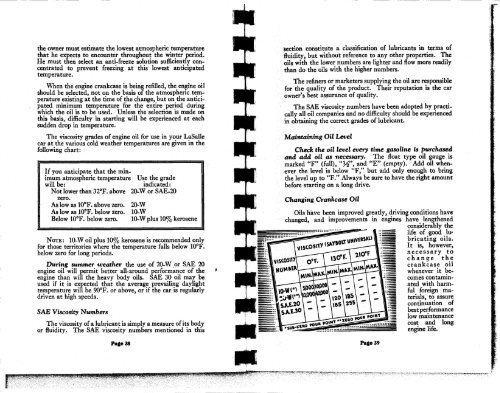1938 Cadillac V16 - GM Heritage Center
1938 Cadillac V16 - GM Heritage Center
1938 Cadillac V16 - GM Heritage Center
You also want an ePaper? Increase the reach of your titles
YUMPU automatically turns print PDFs into web optimized ePapers that Google loves.
the owner must estimate the lowest atmospheric temperature<br />
that he expects to encounter throughout the winter period.<br />
He must then select an anti-freeze solution sufficiently concentrated<br />
to prevent freezing at this lowest anticipated<br />
temperature.<br />
When the engine crankcase is being refilled, the engine oil<br />
should be selected, not on the basis of the atmospheric temperature<br />
existing at the time of the change, but on the anticipated<br />
minimum temperature for the entire period during<br />
which the oil is to be used. Unless the selection is made on<br />
this basis, difficulty in starting will be experienced at each<br />
sudden drop in temperature.<br />
The viscosity grades of engine oil for use in your LaSalle<br />
car at the various cold weather temperatures are given in the<br />
following chart:<br />
If you anticipate that the minimum<br />
atmospheric temperature Use the grade<br />
will be:<br />
indicated:<br />
Not lower than 32°F. above 20-W or SAE-20<br />
zero.<br />
As low as 10°F. above zero. 20-W<br />
As low as 10°F. below zero. 10-W<br />
Below 10°F. below zero. 10-W plus 10% kerosene<br />
NOTE: 10-W oil plus 10% kerosene is recommended only<br />
for those territories where the temperature falls below 10°F.<br />
below zero for long periods.<br />
During summer weather the use of 20-W or SAE 20<br />
engine oil will permit better all-around performance of the<br />
engine than will the heavy body oils. SAE 30 oil may be<br />
used if it is expected that the average prevailing daylight<br />
temperature will be 90°F. or above, or if the car is regularly<br />
driven at high speeds.<br />
SAE Viscosity Numbers<br />
The viscosity of a lubricant is simply a measure of its body<br />
or fluidity. The SAE viscosity numbers mentioned in this<br />
Page 38<br />
section constitute a classification of lubricants in terms of<br />
fluidity, but without reference to any other properties. The<br />
oils with the lower numbers are lighter and flow more readily<br />
than do the oils with the higher numbers.<br />
The refiners or marketers supplying the oil are responsible<br />
for the quality of the product. Their reputation is the car<br />
owner's best assurance of quality.<br />
The SAE viscosity numbers have been adopted by practically<br />
all oil companies and no difficulty should be experienced<br />
in obtaining the correct grades of lubricant.<br />
Maintaining Oil Level<br />
Check the oil level every time gasoline is purchased<br />
and add oil as necessary. The float type oil gauge is<br />
marked "F" (full), "Y 2<br />
", and "E" (empty). Add oil whenever<br />
the level is below "F," but add only enough to bring<br />
the level up to "F." Always be sure to have the right amount<br />
before starting on a long drive.<br />
Changing Crankcase Oil<br />
Oils have been improved greatly, driving conditions have<br />
changed, and improvements in engines have lengthened<br />
considerably the<br />
life of good lu*<br />
bricating oils.<br />
It is, however,<br />
necessary to<br />
change the<br />
crankcase oil<br />
whenever it becomes<br />
contaminated<br />
with harmful<br />
foreign materials,<br />
to assure<br />
continuation of<br />
best performance<br />
low maintenance<br />
cost and long<br />
engine life.<br />
Page 39
















